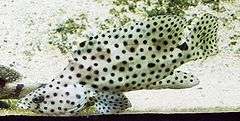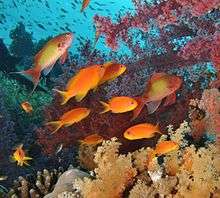Serranidae
| Serranidae | |
|---|---|
 | |
| Humpback grouper, Cromileptes altivelis | |
| Scientific classification | |
| Kingdom: | Animalia |
| Phylum: | Chordata |
| Class: | Actinopterygii |
| Order: | Perciformes |
| Suborder: | Percoidei |
| Superfamily: | Percoidea |
| Family: | Serranidae Innamura & Yabe, 2002 |
| Subfamilies | |
|
Anthiinae | |
| Synonyms | |
|
Grammistidae | |
The Serranidae are a large family of fishes belonging to the order Perciformes. The family contains about 450 species in 64 genera, including the sea basses and the groupers (subfamily Epinephelinae). Although many species are small, in some cases less than 10 cm (3.9 in), the giant grouper (Epinephelus lanceolatus) is one of the largest bony fishes in the world, growing to 2.7 m (8 ft 10 in) in length and 400 kg (880 lb) in weight.[1]
Characteristics
Many serranid species are brightly colored, and many of the larger species are caught commercially for food. They are usually found over reefs, in tropical to subtropical waters along the coasts. Serranids are generally robust in form, with large mouths and small spines on the gill coverings. They typically have several rows of sharp teeth, usually with a pair of particularly large, canine-like teeth projecting from the lower jaw.[2]
All serranids are carnivorous. Although some species, especially in the Anthiinae subfamily, only feed on zooplankton, the majority feed on fish and crustaceans. They are typically ambush predators, hiding in cover on the reef and darting out to grab passing prey. Their bright colours are most likely a form of disruptive camouflage, similar to the stripes of a tiger.[2]
Many species are protogynous hermaphrodites, meaning they start out as females and change sex to male later in life.[2] They produce large quantities of eggs and their larvae are planktonic, generally at the mercy of ocean currents until they are ready to settle into adult populations.
As other fish, serranids harbour parasites, including nematodes, cestodes, digeneans,[3] monogeneans, isopods, and copepods. A study conducted in New Caledonia has shown that coral reef-associated serranids harbour about 10 species of parasites per fish species.[4]
Classification


Recent molecular classifications challenge the validity of the genera Cromileptes (sometimes spelled Chromileptes) and Anyperodon. Each of these two genera has a single species, which were included in the same clade as species of Epinephelus in a study based on five different genes.[5]
- Subfamily Anthiinae
- Anatolanthias
- Anthias
- Caesioperca
- Caprodon
- Dactylanthias
- Giganthias
- Hemanthias
- Holanthias
- Hypoplectrodes
- Lepidoperca
- Luzonichthys
- Meganthias
- Nemanthias
- Odontanthias
- Othos
- Plectranthias
- Pronotogrammus
- Pseudanthias
- Rabaulichthys
- Sacura
- Selenanthias
- Serranocirrhitus
- Tosana
- Tosanoides
- Trachypoma
- Subfamily Epinephelinae (groupers)
- Aethaloperca
- Alphestes
- Anyperodon
- Aulacocephalus
- Cephalopholis
- Chromileptes
- Dermatolepis
- Epinephelides
- Epinephelus
- Gonioplectrus
- Gracila
- Grammistops
- Mycteroperca
- Niphon
- Paranthias
- Plectropomus
- Pogonoperca
- Saloptia
- Triso
- Variola
- Subfamily Grammistinae (soapfishes)
- Belonoperca
- Rypticus
- Diploprion
- Aporops
- Pseudogramma
- Suttonia
- Grammistes
- Subfamily Liopropomatinae
- Bathyanthias
- Jeboehlkia
- Liopropoma
- Rainfordia
- Subfamily Serraninae
- Acanthistius
- Bullisichthys
- Centropristis
- Chelidoperca
- Cratinus
- Diplectrum
- Hypoplectrus
- Paralabrax
- Parasphyraenops
- Schultzea
- Serraniculus
- Serranus
- incertae sedis
- Caesioscorpis
- Hemilutjanus
- †Palaeoperca (Eocene, Germany)
Timeline of genera

Notes
- ↑ Froese, Rainer and Pauly, Daniel, eds. (2012). "Epinephelus lanceolatus" in FishBase. May 2012 version.
- 1 2 3 Randall, John E. (1998). Paxton, J.R.; Eschmeyer, W.N., eds. Encyclopedia of Fishes. San Diego: Academic Press. pp. 195–199. ISBN 0-12-547665-5.
- ↑ Cribb, T. H.; Bray, R. A.; Wright, T.; Pichelin, S. (2002). "The trematodes of groupers (Serranidae: Epinephelinae): knowledge, nature and evolution". Parasitology. 124: S23–S42. doi:10.1017/s0031182002001671.
- ↑ Justine, J.-L.; Beveridge, I.; Boxshall, G. A.; Bray, R. A.; Moravec, F.; Trilles, J.-P.; Whittington, I. D. (2010). "An annotated list of parasites (Isopoda, Copepoda, Monogenea, Digenea, Cestoda and Nematoda) collected in groupers (Serranidae, Epinephelinae) in New Caledonia emphasizes parasite biodiversity in coral reef fish". Folia Parasitologica. 57: 237–262. doi:10.14411/fp.2010.032. PMID 21344838.
- ↑ Schoelinck, C.; Hinsinger, D. D.; Dettaï, A.; Cruaud, C.; Justine, J.-L. (2014). "A phylogenetic re-analysis of groupers with applications for ciguatera fish poisoning". PLoS ONE. 9: e98198. doi:10.1371/journal.pone.0098198.
References
- Froese, Rainer, and Daniel Pauly, eds. (2006). "Serranidae" in FishBase. January 2006 version.
- Sepkoski, Jack (2002). "A compendium of fossil marine animal genera". Bulletins of American Paleontology. 364: 560. Retrieved 2011-05-19.